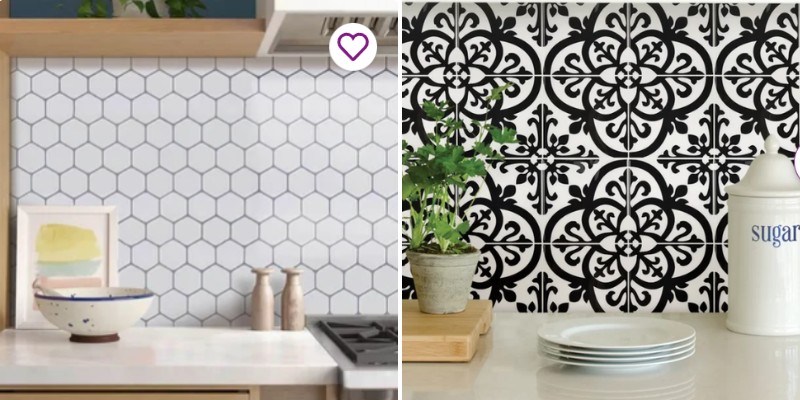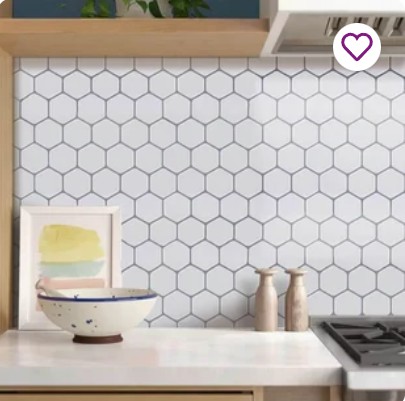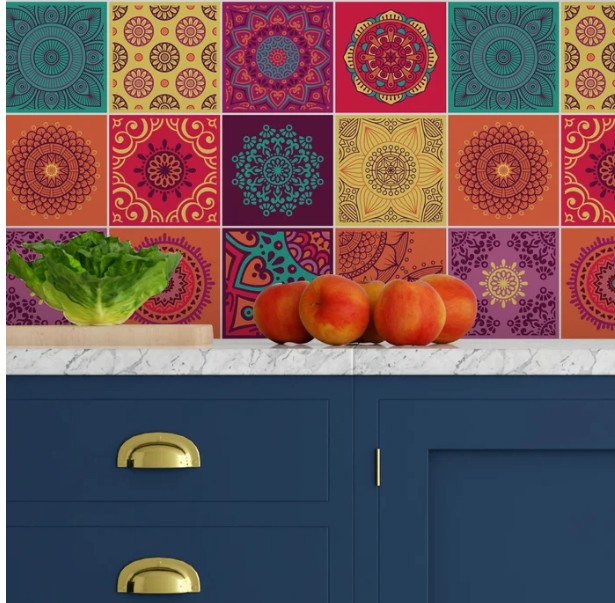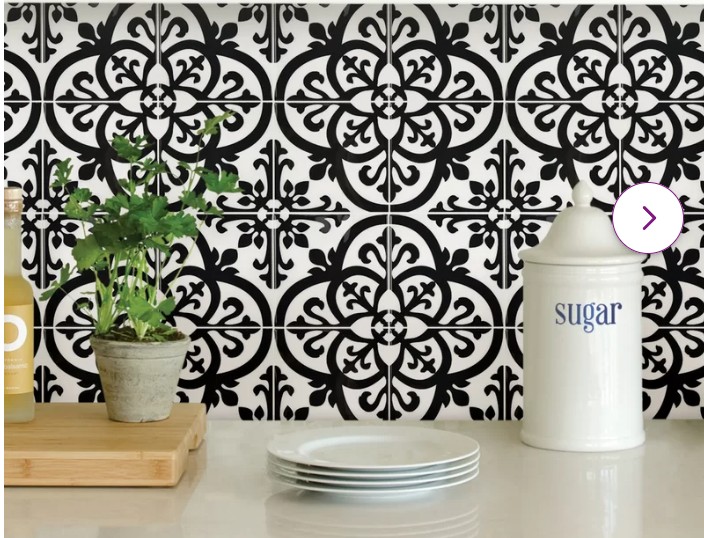When you think about it, the backsplash in a kitchen is likely what your eyes will see first when you enter the space.
It is practically at eye level and is the common thread or band that separates the countertop from the upper cabinets, tying everything together.

Backsplashes are also popular in home bars, bathrooms, and laundry rooms. This horizontal surface protects your walls from water, scratches, and splatters.
Most are very cleanable. There are a wide variety of backsplash materials: ceramic tile, stone, glass, metal, and wood to name the most common. These are all fabulous choices. Yet, they often require a professional to install them.
If you are a DIY kind of person, there is another option. Peel-and-stick backsplashes are something you can install yourself.
This is basically a sheet of material with an adhesive backing that sticks to almost any flat wall surface.
There are some pros and cons to using peel-and-stick backsplash that we’ll explore in this article.
Pros of Peel-and-Stick Backsplash Tile
1. Affordable Option
There are many options with peel-and-stick backsplash materials, such as ceramic tile, sheet vinyl, glass tile, metal, stone, and gel.
The flatter materials generally come in sheets that are incredibly affordable. You can cover 7 linear feet for around $10.00.
3-dimensional materials, such as ceramic and glass tiles are available in panels or individual pieces that can cost an average of $16.00 per square foot.
The good news is that any of these can be installed without having to hire a contractor. This results in a very economical project.
2. Easy to Install
When you think about all the labor that goes into a traditional tile backsplash, it is easy to see why you might opt for a peel-and-stick material.

Traditional ceramic, stone, and glass tiles require a setting bed and grout. Solid glass needs to be properly cut into sheets and secured with a pristine adhesive.
And stone slabs are heavy and need a master to template the surface area. You also need tools, such as a wet saw, trowels, spacers, clips, and sponges.
With peel-and-stick, you only need a measuring tape, a cutting tool, and a little dexterity for lining up the seams. In general, this type of backsplash can be installed in one day or over a weekend.
3. Easy to Remove
Let’s say your home or apartment doesn’t have a backsplash. It is simply painted sheetrock and you want to make the space between the countertops and the cabinets more sanitary and aesthetically appealing.
You can easily place a peel-and-stick tile backsplash up and see how you like it and how easy it is to clean.
If you don’t really like it, just peel it off and try another surface finish that looks better and is a cinch to wipe down. This is especially convenient if you are a tenant.
4. Great for Renters
As mentioned, peel-and-stick backsplashes are great for renters because you can remove them before you vacate without risking losing your security deposit.
Also, it doesn’t make economical sense to put a permanent backsplash into a rented apartment or house.
There is no return on that investment for you, only for the landlord. An adhesive-applied backsplash can transform a basic rental unit into a space with a unique personality.
5. Wide Variety of Materials and Designs
Once you have made the decision to go with a peel-and-stick tile backsplash in your kitchen, bathroom, laundry room, or bar, it’s time to go shopping and see what your options are.
There are many to choose from. Tile panels can be glass, ceramic, stone, metal, or gel. These surfaces are 3-dimensional and some do require that you apply grout between the joints.
Sheets are available in vinyl, real and faux leather, and mirrored finishes. Vinyl sheets are often realistic photos of natural materials, such as ceramic and stone tiles, or even wood, with a foam or plastic backing. The patterns and designs are endless.
Cons of Peel-and-Stick Backsplash Tile
1. Doesn’t Last Very Long
Not all peel-and-stick materials are created equal and some last longer than others. If you use real tiles that come on an adhesive-backed sheet, there shouldn’t be much discoloration or deterioration of the surface.
Yet, it still takes proper cleaning and maintenance to keep the tiles looking fresh. Vinyl sheets can become damaged and even fade with routine cleaning.
Harsh chemicals used for cleaning could damage the surface or deteriorate the adhesive backing.
This generally isn’t an issue with conventional tile backsplashes that are properly installed with an adhesive setting bed.
2. Has an Inexpensive Appearance
Peel-and-stick backsplash tiles are generally thinner than individual ceramic, glass, or stone tiles.
You won’t achieve the same depth and appearance with peel and stick and this might give the kitchen or other space the appearance that it was a low-budget project.

This is especially true when using certain vinyl backsplash materials that have no depth at all.
If you own your home and intend to sell, a peel-and-stick backsplash won’t win many accolades from discerning buyers.
3. Requires Proper Wall Surface and Preparation to Install
A peel-and-stick backsplash installation can be tricky if your wall surface is not completely flush.
This is especially true for older homes that have plaster walls or areas with a bowed structure.
Uneven walls can cause the adhesive backing to fail over time. It is best to apply over walls that are square and level so that seams line up and the backsplash appears uniform.
Otherwise, traditional individual tiles are a better option because the setting material can be feathered to make up for inconsistencies in the wall surface.
4. The Adhesive Backing can Deteriorate from Moisture
The adhesive used on the back of peel-and-stick tile backsplashes can wear down over time. This is especially true in areas of high moisture, such as a bathroom. It is not recommended that you install peel and stick tiles in a shower, around a bath, or in a steam room for this very reason.
5. Difficult to Line Up Seams and Cut-outs for Electrical Outlets and Fixtures
Once you have made the decision to install a peel-and-stick tile backsplash, you will need sharp cutting tools that are recommended by the manufacturer.
You also need a square, a tape measure, and steady hands. Lining up seams and achieving clean edges around outlets, switches, and fixtures might take some practice, so make sure you buy a little extra material and even practice on a countertop before removing the protective layer over the adhesive backing.
It can be frustrating if you adhere a sheet and the adjacent one doesn’t align perfectly, so take your time.
Different Material Types of Peel-and-Stick Tile
As mentioned, there are a variety of peel-and-stick tiles for backsplashes. Some look better than others and some are easier to install than others. Here are the most common:
Glass:
Glass tile is elegant and gives a kitchen an airy and bright feeling. These tiles come in a variety of shades and have a glossy finish.
You can purchase individual tiles that stack on top of one another. These are generally larger tiles.
Mosaic glass tiles come in small panels or sheets. With either installation, you will need a specific glass tile cutter. But you don’t need grout for the joints.
Vinyl:

Vinyl tiles are arranged on a sheet with a foam or plastic backing. These can have a slight relief for a 3-dimensional effect or can be more like flat wallpaper with a photographic depiction of a tile pattern.
Vinyl is easy to install and can be cut with specialty scissors or a sharp utility knife and a straightedge. Vinyl is a very affordable option.
Metal:
Metal tiles are generally available in 12 x 12-inch panels and are very thin and light. These are often made from aluminum or stainless steel.
The metal is adhered to a PVC sheet with a foam tape backing. You can achieve the look of a vintage tin ceiling if desired.
Metal is very sanitary and easy to clean. However, it is a little more expensive than other materials.
Natural Stone:
Natural stone peel-and-stick tiles are made from real organic stone, such as marble, slate, travertine, and quartzite.
The benefit of natural stone is the depth and texture of the tile for a more traditional look and feel. The tiles are often mosaic and come in 12 x 12-inch sheets. These sheets don’t require grout.
Stone Veneer:
Stone veneer consists of engineered stone, a composite material comprised of crushed natural stone, such as slate, quartzite, marble, or sandstone, and a binding agent. It has only a slight 3-dimensional effect.
These products generally come in 6 x 24-inch sheets and are super easy to install. You can cut the sheets with specialty shears. Veneer sheets are only 1/8-inch in thickness.
Gel:
Hardened silica gel peel-and-stick tile is a flexible material with a soft feel. Gel products have the benefit of depth to look more like authentic glass or ceramic tile, yet they are as easy to install as vinyl and just as easy to wipe clean.
Related Posts
- 11 Ways to Get Rid of Cooking Smells in a Small Apartment or House
- Comparison of Corian Countertops vs Laminate for Kitchens
- All About Fragranite Kitchen Sinks With Pros & Cons
- Comparison of Granite Composite Sink vs Stainless Steel
- How Much Does it Cost to Paint Kitchen Cabinets?
- What Color Granite Goes With Maple Wood Kitchen Cabinets?
Leave a Reply